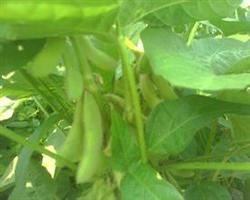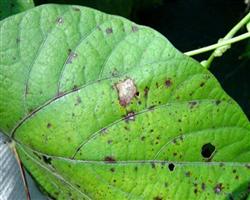Oil-increasing cultivation of soybean

1. Variety selection and seed treatment (1) select varieties with high oil content, strong resistance to diseases and insect pests, moderate maturity and full maturity before frost, mainly Kenjiandou 25 and Kenjiandou 27; (2) seed selection before seed description, mix seeds with 0.1-0.3% of the amount of borax seeds. 2. Corn stubble is the best stubble, followed by wheat, sugar beet stubble is the most disadvantageous to the formation of oil content, and continuous cropping soybean is not conducive to the formation of oil content, so heavy stubble land should be avoided. 3. Early sowing at the right time is beneficial to the improvement of oil content, and the local requirement is to finish sowing before May 10. 4. Fertilizing and applying potassium sulfate or potassium sulfate compound can not only supplement potassium but also increase sulfur, which can increase the oil content of soybean. 5. during the full bloom of foliar topdressing, spraying sulfur (40 mg / kg) and boron (200 mg / kg) can increase the oil content by 1% to 2%. Be careful not to apply molybdenum, manganese, platinum and manganese will reduce the oil content. 6. Pest control at the end of July and the beginning of August, foliar spraying 2.5% bromocyanide 30ml / mu to control heart borer and 50% carbendazim 100g / mu to control gray spot can increase oil content, both of which should be used as routine measures for the production of high-oil soybean. 7. Dense planting is not conducive to the increase of oil content, so the density should be reduced properly. 28 ~ 300000 seedlings per hectare of Kenjiandou 25 and 27 are required in this area. 8. If there are conditions for irrigation, soybean can be irrigated from podding stage to grain filling stage to improve oil content. 9. Harvest (1) when the soybean is in yellow maturity, more than 70% of the leaves fall off, and sectional harvest is beneficial to increase the oil content; (2) during harvest, we should adopt single harvest, single storage and single sale of different varieties to prevent mixed beans from reducing oil content.
- Prev

Control techniques of Soybean Gray Leaf spot
1. Disease: mainly harms the leaves at the adult stage, and infects seeds, seedlings, stems and pods. Round brown spots appeared on the cotyledons of young seedlings born with diseased grains. Irregular plaques may also be formed in the later stage. When it is wet, the central part of the disease spot on the back of the leaf is full of gray mildew layer, which is the conidia of the pathogen. 2. Prevention and control methods:.
- Next

Technical points of planting black sesame
1. Soil preparation and fertilization: choose sandy loam or loam fields with loose soil, good air permeability and medium-to-high fertility, and avoid continuous cropping. At the end of May and the beginning of June, 15 kg of urea vegetables or 25 kg of ammonium bicarbonate and 5-10 kg of potassium chloride were applied per mu. 2. Seed treatment: sun-drying seeds for 1-2 days before sowing. Just in case.
Related
- The first cup of black tea in spring, the flavor and history of tea gardens in Kenya, Africa
- The computer can not only choose potatoes, but also grow tea rice. AI will grow winter oolong tea champion.
- It is not only the inflated tea bitten by insects, but also engraved with the four seasons tea in Beipu.
- The Oriental Beauty Tea Festival in Zhuxian County takes the stage at the weekend to experience the plus-size feast of oil tea.
- & quot; Oriental Beauty Tea & Exploration of Emei in Hsinchu, the hometown of quot;
- The new variety of strawberry "Tainong 1" dessert is the first choice with mellow aroma. Crimson gorgeous
- History of Tea in Taiwan: from Wild Inner Mountain to Export Tea Garden
- Two types of Taiwan Oriental Beauty Black Tea won the British three-Star Award for Childhood Tea Xiang Zhang Jiaqi changed from pilot to champion tea maker.
- Banana species and varieties: the planting history of Taiwan Xianren banana and dwarf banana is long, is banana disease resistant?
- Coffee planting Technology: Qianjie Coffee from Seedling to harvesting

